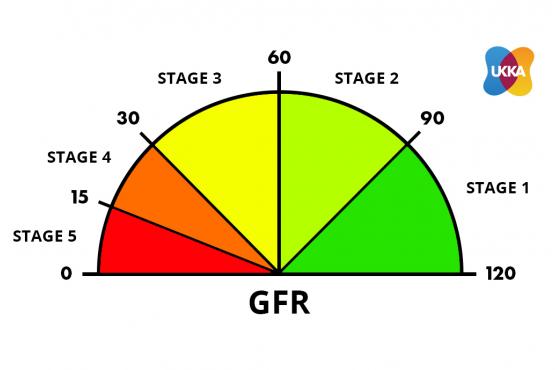How often should GFR/creatinine be monitored?
Keep track of your kidney data with PKB
It depends on the eGFR and creatinine level in the blood, as shown by these key points.
Key Points
- In CKD1-2 (Risk factors for CKD) – measure eGFR/creatinine every 12 months
- CKD3A (Mild CKD) – eGFR/creatinine every 6 months
- CKD3B (Mild CKD, but worse than CKD3A) – eGFR/creatinine every 4-6 months
- CKD4 (Moderate CKD) – eGFR/creatinine every 2-4 months
- CKD5 (Severe CKD, approaching dialysis) – eGFR/creatinine every 1-2 months.
What is CKD?
The diagnosis and monitoring of CKD is based on a classification of its severity, based on something called ‘eGFR’ (estimated glomerular filtration rate) – the higher the eGFR, the better. Normal eGFR in humans is 90-120 mls/min. The eGFR is based on a simple blood test called creatinine (normal range 60-120 mcmol/L); the lower the creatinine, the higher is the GFR, the better.
The CKD classification has 5 grades:
CKD1+2: risk factors for CKD (eGFR 60-120 mls/min; with evidence of kidney damage) – no symptoms
CKD3: mild CKD (eGFR 30-59 mls/min) – no or very mild symptoms
CKD4: moderate CKD (eGFR 15-29 mls/min) – moderate symptoms
CKD5: severe CKD (kidney failure; eGFR < 15 mls/min) – severe symptoms (require dialysis or a transplant).

Courtesy of UKKA
Monitoring of chronic kidney disease (CKD)
CKD1-2. Risk factors for CKD. Creatinine – normal (< 120 mcml/L)
- eGFR/creatinine should be measured every 12 months
CKD3A. Mild CKD. Creatinine – normal or <150 mcmol/L
- eGFR/creatinine every 6 months
CKD3B. Mild CKD (but worse than CKD3A). Creatinine usually 150-200 mcmol/L
- eGFR/creatinine every 4-6 months
- Urinary ACR (uACR) – if monitoring the protein level in the urine is important in your disease – every 6 months
CKD4. Moderate CKD. Creatinine usually 200-400 mcmol/L
- eGFR/creatinine every 2-4 months
- Urinary ACR, if needed, every 4 months
CKD5. Severe CKD (approaching dialysis). Creatinine >400 mcmol/L
- eGFR/creatinine every 1-2 months
Note. When on dialysis, and when stable, the frequency of monitoring can go down, to every 6 months.
Other things to monitor in CKD
- Blood pressure. Should be under 140/90 all the time, <130/80 if you have diabetes or under 65 years
- Haemoglobin. If <100 g/L, anaemia (that can be caused by CKD) is worsening, and your doctor should consider erythropoeitin (EPO) injections
- Medication. These need regular review
- The underlying cause of CKD. A yearly thought is a good idea. Why? The original diagnosis may have been wrong (what was the evidence for it?); and patients may develop a second cause for CKD, and the treatments for each may be different or conflicting
Summary
We have described how often should GFR/creatinine be monitored. We hope it has helped you.
Top Tip
Keep a note in your diary when your next kidney blood test is due. If you are not called up for it by your GP, contact them and sort it out yourself. Look up the test result on the Patient Knows Best website.
Last Reviewed on 26 June 2024
